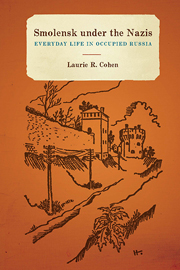Book contents
- Frontmatter
- Contents
- Acknowledgments
- Abbreviations
- Introduction
- Part 1 Methodologies
- Part 2 A Record of the War and Occupation
- Part 3 Popular Attitudes, Propaganda, and Enemy Imagery
- 6 Between Stalinists and Nazis: The Long-Term Aims and Long-Lasting Effects of Occupation
- 7 Propaganda and Persuasion
- 8 Group Perceptions, Oral Narratives
- 9 Sex/Gender Relations and Youth Experiences
- Part 4 Restoration and Reconstruction
- Conclusion
- Notes
- Bibliography
- Index
8 - Group Perceptions, Oral Narratives
from Part 3 - Popular Attitudes, Propaganda, and Enemy Imagery
Published online by Cambridge University Press: 05 December 2013
- Frontmatter
- Contents
- Acknowledgments
- Abbreviations
- Introduction
- Part 1 Methodologies
- Part 2 A Record of the War and Occupation
- Part 3 Popular Attitudes, Propaganda, and Enemy Imagery
- 6 Between Stalinists and Nazis: The Long-Term Aims and Long-Lasting Effects of Occupation
- 7 Propaganda and Persuasion
- 8 Group Perceptions, Oral Narratives
- 9 Sex/Gender Relations and Youth Experiences
- Part 4 Restoration and Reconstruction
- Conclusion
- Notes
- Bibliography
- Index
Summary
This war turns out to be a more complicated affair than it looked at the beginning; and we should try to focus our eyes on real people, not the glamour-soldiers and soldierettes of propaganda posters. Talking of real people, we may distinguish two main categories: those who have personally experienced the Nazi-Fascist ways, and those who have not.
—Arthur Koestler, 1943Operation Barbarossa's impact on the Smolensk community was multi-dimensional. Along with the physical suffering imposed by the war (e.g., a ruined urban infrastructure, food shortages, disease, arrest, executions), the National Socialist invasion and occupation provoked new and shameful political, ethnic, and social distinctions. In part this was accomplished through Nazi propaganda efforts, as described in the previous chapter. The present chapter, relying mostly on material obtained from five in-depth oral history interviews (as well as interviews of Smolensk refugees by the Harvard Project), analyzes how the propaganda was alternately absorbed and deflected and how various groups—Germans, Jews, collaborators, partisans—were perceived by some of the local population. Much of this chapter's analysis adheres to insights gained from basic findings of psychoanalysis. Peter Gay has eloquently argued that if, as “G. R. Elton [has said], history ‘is concerned with all those human sayings, thoughts, deeds and sufferings which occurred in the past and have left present deposits,’ then the historian is entitled, in fact obliged, to inquire how those sayings, thoughts, deeds and sufferings can be most effectively investigated and most sensitively understood.”
- Type
- Chapter
- Information
- Smolensk under the NazisEveryday Life in Occupied Russia, pp. 187 - 219Publisher: Boydell & BrewerPrint publication year: 2013



